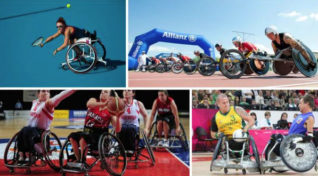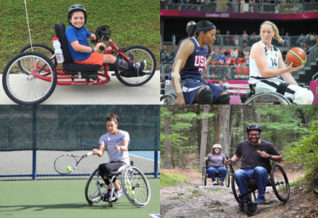Sports wheelchairs are specially designed for speed, agility and safety. Common characteristics of sports wheelchairs are:
- Wheels have a pronounced angle (camber) for stability
- Chairs on non-folding for increased solidity
- Materials are all lightweight
All You Need to Know About Manual Sports Chairs Sizing, Fitting, Transfers, Maintenance and Repair (PDF)
Common types of manual sports wheelchairs:
- Components of sports wheelchairs
- Routine maintenance
- Proper fit for performance
- Classification
- Transfer safety
Considerations when Selecting a Sports Wheelchair
- Will the sports wheelchair work for a specific activity? (Some sports have very specific wheelchair requirements.)
- How competitive do you want to be? (If playing casually, an all-round sports chair might be just fine.)
- Is it the right size? (Sports wheelchairs have varying customization options.)
- Are the seat and push rims comfortable?
- Can the seat cushion be easily cleaned? (Many sports are sweaty affairs.)
- Can castors, wheels or other kit be used to change or upgrade the wheelchair?
- If you are going to be competing, does the wheelchair meet the regulations governing the sport?
Overview of Sports Wheelchairs
The adaptations for sports abound. Below is an overview of wheelchairs design for a few sports.
Wheelchairs for Basketball
For wheelchair basketball, players use lightweight wheelchairs with pressured tires that allow for quick and easy maneuvering. The basic design of wheelchairs for basketball is optimized for enhanced stability with a low seat and wheels that are angled out. Even more specialized wheelchairs are available for specific positions. Wheelchairs for forwards and centers have higher seats to give them more reach for shooting and catching rebounds. Guards have lower seats to give them more stability.
Learn more about wheelchair basketball.
Wheelchairs Tennis
Players use lightweight sports wheelchairs that have a few features that differentiate them from standard wheelchairs.
- Cambered, or angled, wheels to increase lateral stability and for quicker turn radius
- No armrests
- No brakes
- No push handles
- Usually have one front caster, like a roller blade wheel (some have two for anti-tip)
- Anti-tip wheel in rear
Learn more about wheelchair tennis.
Wheelchairs for Handicapped Hiking
Depending on the trail, more rugged wheelchairs and handcycles make hiking more accessible. These usually have mountain-bike-style tires (and others offer treads) on three, four or five wheels depending on chair model.
Learn more about wheelchair hiking.
Wheelchairs for Adaptive Cycling
Adaptive cycling or para-cycling accommodates individuals of varying abilities with modified bikes for both street and off-road riding. These include handcycles adaptive tricycles, adaptive tandem bikes, low-step bikes and wheelchair cycles – all of which are available with a number of modifications to gear and braking systems to accommodate riders.
Learn more about adaptive cycling.
Wheelchairs for Racing
Racing wheelchairs are very lightweight with two large wheels and a small wheel – all have pneumatic tires. They are designed to be very lightweight and are custom-made to fit each athlete’s physique and disability.
Learn more about wheelchair racing.
Quad Rugby or Wheelchair Rugby Chairs
For competitive quad or wheelchair rugby, participants use special chairs which are usually made of aluminum or titanium and include a set of anti-tip wheels. Wheels are also set at an angle (or cambered) to provide greater stability and maneuverability. Offensive and defensive players’ chairs have a few differences including:
- Offensive rugby wheelchairs
- Used by a higher point class
- Have an aluminum ram rod in the front of the chair
- Have aluminum “wings” from the end of the ram rod that extends to the front of the wheel.
- Defensive rugby wheelchairs
- Used by lower point class
- Have a picking guard or hook on the front of the chair (to pick the opposing player)
Learn more about quad rugby or wheelchair rugby.
Paralympics on Wheelchairs for Wheelchair Sports
Paralympic Movement, organizers of the Paralypic Games, provides a detailed description of the features and functions of different sports wheelchairs. The article highlights differences in:
- Push rims
- Seating
- Extra equipment
- Sports wheelchairs for contact and non-contact sports



Leave a Reply